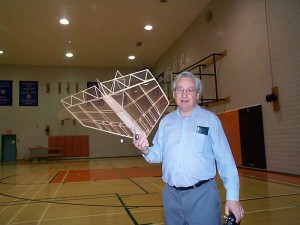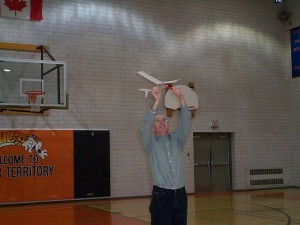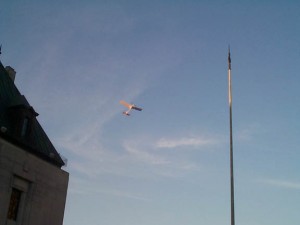Sheet balsa designs and picnic ideas

By the end of summer 2004, I realized that the answer to sharing model airplanes was simplicity. Well I knew it before but I then new more than ever that the average person doesn’t have the childhood experiences of the average modeler so the more we could simplify the better.
A few Shots from Summer 2004
The stick and tissue designs had proven to be good flyers but the complexity was so high. Each person needed a lot of mentor-ship and support. The chance of them abandoning a project and picking up the TV remote control or a computer game was very high.
I tried some of Don Rosses sheet designs. They were superior as beginner models because they flew well and had a minimal number of parts.
The Canarsie Canarie and the Canarsie Courier are perhaps the coolest picnic airplanes. They fly great and his building techniques are pretty ingenious. I figured that the Canarie (the small one in the picture) qualifies as the ultimate beginner model.
As you can see above I started sharing with a larger number of people at a time. The Canarie served its purpose very well with its good performance and super simple construction. There were actually four areas that I struggled with when I was dealing with groups of younger people.
Firstly, the gull wing construction (which is ingenious in my opinion) works great for a person with familiarity with balsa and high manual dexterity. But the crack and re-glue technique can lead to broken wings when you have a group of 15-20 ten year olds. The remedy was to do this for them. I wound up doing this before each workshop so if I had 20 kits, I had to have 20 wings prepared.
The second thing that I was having trouble with was the music wire motor hangar. You need to cut the music wire with side trimmers or pliers. The wire often flies of very fast when cut. It takes a good pair of cutters and sometimes a bit of strength. I started by bringing raw wire and pliers to workshops. That was a bit of a nightmare and I had to help each child fasten their rear motor hangar because if this wire hook flew off, it would be an eye risk. This was a lot of work. Eventually I would make and attach the rear hangar for each workshop.
Being a sheet model, it gets a little heavy unless you have high quality light balsa which is very expensive. For an individual a $4.00 sheet of balsa is a good deal given what wonderful model the Canarie is. And it will last a long while. But a person like myself who gives planes out by the hundred, this is a bit of a setback.
Lastly, being a sheet model it uses a lot of material as compared to a stick and tissue model.
Either way, it was definitely the best model around for my purposes. So I did the two challenging steps (make and attach rear motor hangar, make winglets) as a pre-process to my workshops and sharing activities. That way the children and other newcomers to the hobby would get a sense of building it and then flying it.
So the Canarie was a big success. But one day when I was in a rush because my ballroom partner Suzanne was picking me up for some lessons, I had an accident. When I was preparing for a workshop for the following day (trying to finish before Suzanne arrived), I cut myself very badly. I wont to into the details but I’ll say it was a very bad injury that cost me some work.
So I realized that there was room for another design. I wanted to make a balsa and tissue design that would be as simple as possible and would not require any pre-assembly for the smaller children.












































